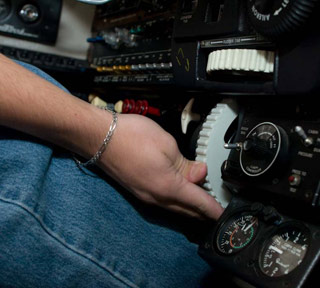 Trim makes flying facile. Set power and pitch for the airspeed and vertical rate you desire. Then a trim adjustment lets you fly “hands off” until a change is necessary.
Trim makes flying facile. Set power and pitch for the airspeed and vertical rate you desire. Then a trim adjustment lets you fly “hands off” until a change is necessary.
Retrimming isn’t always needed when making changes: If you have been flying straight and level and wish to descend at the same airspeed, simply reduce power. The aircraft will pitch down slightly and descend at your trimmed airspeed—easy!
A configuration change such as adding flaps requires that you adjust the pitch attitude to maintain a constant airspeed, then retrim. With practice you can make this a simple process. For example, in a high-wing Cessna 150, adding 10 degrees of flaps will cause the nose to pitch up slightly—but if you reduce power slightly just after setting the flap position, the nose-down response to the power change should cancel out the nose-up effect of adding flaps.
What’s a better idea during a rapid series of airspeed and/or configuration changes, or when practicing maneuvers: retrimming for each, or simply holding the needed control pressures? That’s a question many student pilots ask as they work to master trim technique.
One answer doesn’t fit all scenarios or apply to all aircraft. An aircraft that is light in pitch and easily controlled with yoke or stick pressure may make less trim demand on the pilot during a maneuver than, say, a four-seat aircraft with a reputation for nose heaviness, that is being flown at a center-of-gravity position close to the forward limit, as would be the case with only the front seats occupied.
In any aircraft, the answer also depends on the flight task. A brief climb to correct a minor altitude excursion, after which you will resume your previous cruise airspeed, could be accomplished with a simple addition of power and back-elevator pressure, followed by leveling off and returning to your cruise power setting. By contrast, a 360-degree steep turn might prove difficult without some assistance from the trim system to help you maintain the needed up-elevator input.
One scenario in which trimming is the safe choice is during landing—especially when close to the ground.
"Ground effect decreases elevator control effectiveness and increases the effort required to raise the nose," explains the Airplane Flying Handbook.
Let the trim system help keep your flying smooth—and safe!

